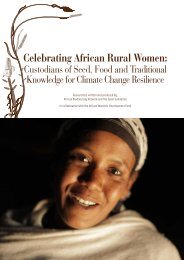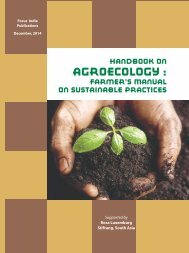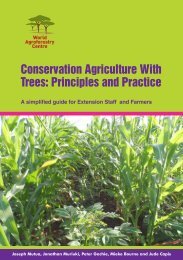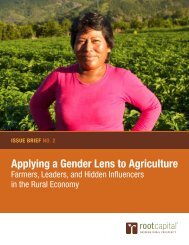1t0SC7l
1t0SC7l
1t0SC7l
Create successful ePaper yourself
Turn your PDF publications into a flip-book with our unique Google optimized e-Paper software.
SUMMARY<br />
Slash and burn or shifting cultivation is a traditional farming system found in many parts of the<br />
humid tropics in general and in Cameroon in particular. Information on farming system in the<br />
moist evergreen forest of southern Cameroon is limited and very sparse. Although the<br />
Cameroon forest action plan did not foresee a significant agricultural pressure on forest land in<br />
southern Cameroon, the shifting cultivation component of the farming system practices may<br />
represent a greater threat to forest conservation than timber exploitation. Understanding the<br />
shifting cultivation practices and the trends and relationships between field expansion, soil<br />
degradation, crop yields and socio-economic factors may provide a basis for determining<br />
research and development strategies and priorities for the improvement of agricultural<br />
production and forest conservation and the achievement of sustainable use of the moist<br />
evergreen forest land. Between 1995 and 1997, a study on this agricultural system practised by<br />
the Bantu population was conducted in the research area of the Tropenbos-Cameroon<br />
Programme (TCP). The general objective was to reduce destructive effects of shifting<br />
cultivation on the forest by proposing to farmers complementary and / or alternative sedentary<br />
practices and by providing information to be utilised for the sustainable forest land use in<br />
southern Cameroon. The methodology followed in the farming system study consisted of site<br />
selection, collection of secondary data through consultation of existing documents, interviews of<br />
key informants and collection of primary data through participatory exploratory survey, case<br />
studies and on farm measurements. The methodology followed in soil degradation study<br />
consisted of site selection, soil description and sampling for laboratory analyses. Trends in<br />
agricultural field expansion were studied by over-laying maps of fields population sample<br />
opened between 1995 and 1997 on the 1984-1985 aerial photo interpretation landscape<br />
ecological map using arc-view software. Results of farming system study showed that a farm in<br />
the evergreen forest of Cameroon is composed of many subsystems interrelated and influenced<br />
by external biophysical and socio-economic parameters. According to 92% of the farmers<br />
interviewed, cropping subsystem remains the first priority activity. In this cropping subsystem,<br />
80% of the farmers considered shifting cultivation involving food crop fields and fallow as their<br />
first priority land use type. Four major crop associations highly linked to the preceding fallow<br />
type were identified in the food crop fields. Today, 76% of food crop fields in the area shift<br />
within fallow of different ages in a rotational system. Only 24% of agricultural fields expand<br />
towards undisturbed forest for cucumber (Cucumeropsis mannii) production and for<br />
establishment of semi-industrial farms by elite. Between 1984 and 1997, the land area under<br />
agricultural use expanded from 31 to 40.3%, for an average annual expansion of 0.71% of the<br />
total land area. The population pressure, the type and objective of crop production, the limited<br />
labour and access to new land have prompted more farmers to abandon the traditional expansive<br />
shifting cultivation to adopt the rotational system. The latter consists of shifting in a total area of<br />
less than 10 hectares, clearing short length fallow. This reduction in fallow length leads to<br />
degradation of topsoil morphology and physico-chemical soil properties. The study of soil<br />
degradation under shifting cultivation showed that the liming effect of ashes from burned<br />
vegetation biomass at the beginning of the cropping period increased significantly (p








